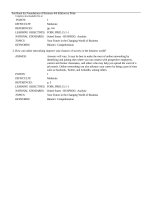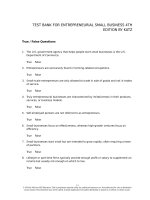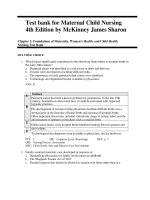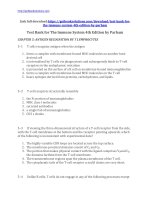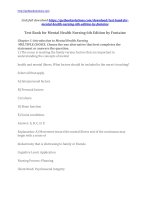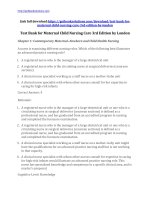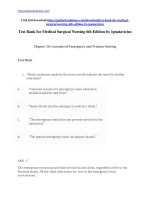Test bank for maternal child nursing 4th edition by mckinney james sharon download
Bạn đang xem bản rút gọn của tài liệu. Xem và tải ngay bản đầy đủ của tài liệu tại đây (914.44 KB, 14 trang )
Test bank for Maternal Child Nursing
4th Edition by McKinney James Sharon
Chapter 1: Foundations of Maternity, Women’s Health, and Child Health
Nursing Test Bank
MULTIPLE CHOICE
1. Which factor significantly contributed to the shift from home births to hospital births in
the early 20th century?
Puerperal sepsis was identified as a risk factor in labor and delivery.
Forceps were developed to facilitate difficult births.
The importance of early parental-infant contact was identified.
Technologic developments became available to physicians.
a.
b.
c.
d.
ANS: D
A
B
C
D
Feedback
Puerperal sepsis has been a known problem for generations. In the late 19th
century, Semmelweis discovered how it could be prevented with improved
hygienic practices.
The development of forceps to help physicians facilitate difficult births was a
strong factor in the decrease of home births and increase of hospital births.
Other important discoveries included chloroform, drugs to initiate labor, and the
advancement of operative procedures such a cesarean birth.
Unlike home-births, early hospital births hindered bonding between parents and
their infants.
Technological developments were available to physicians, not lay midwives.
PTS: 1
DIF: Cognitive Level: Knowledge
OBJ: Nursing Process: Assessment
MSC: Client Needs: Safe and Effective Care Environment
REF: p. 2
2. Family-centered maternity care developed in response to:
a. Demands by physicians for family involvement in childbirth
b. The Sheppard-Towner Act of 1921
c. Parental requests that infants be allowed to remain with them rather than in a
nursery
d. Changes in pharmacologic management of labor
ANS: C
A
B
Feedback
Family-centered care was a request by parents, not physicians.
The Sheppard-Towner Act provided funds for state-managed programs for
mothers and children.
C
As research began to identify the benefits of early extended parent-infant
contact, parents began to insist that the infant remain with them. This
gradually developed into the practice of rooming-in and finally to familycentered maternity care.
D
The changes in pharmacologic management of labor were not a factor in
family-centered maternity care.
PTS: 1
DIF: Cognitive Level: Knowledge
REF: p. 3
OBJ: Nursing Process: Assessment
MSC: Client Needs: Psychosocial Integrity
3. Which setting for childbirth allows the least amount of parent-infant contact?
a. Labor/delivery/recovery/postpartum room
b. Birth center
c. Traditional hospital birth
d. Home birth
ANS: C
A
B
C
D
Feedback
The labor/delivery/recovery/postpartum room setting allows increased
parent-infant contact.
Birth centers are set up to allow an increase in parent-infant contact.
In the traditional hospital setting, the mother may see the infant for only short
feeding periods, and the infant is cared for in a separate nursery.
Home births allow an increase in parent-infant contact.
PTS: 1
DIF: Cognitive Level: Knowledge
REF: p. 3
OBJ: Nursing Process: Planning
MSC: Client Needs: Health Promotion and Maintenance
4. As a result of changes in health care delivery and funding, a current trend seen in the
pediatric setting is:
Increased hospitalization of children
Decreased number of children living in poverty
An increase in ambulatory care
Decreased use of managed care
a.
b.
c.
d.
ANS: C
A
B
C
D
Feedback
Hospitalization for children has decreased.
Health care delivery has not altered the number of children living in poverty.
One effect of managed care has been that pediatric health care delivery has
shifted dramatically from the acute care setting to the ambulatory setting. One of
the biggest changes in health care has been the growth of managed care. The
number of hospital beds being used has decreased as more care is given in
outpatient settings and in the home. The number of children living in poverty
has increased over the last decade.
Managed care has increased in order to control cost.
PTS: 1
DIF: Cognitive Level: Knowledge
OBJ: Nursing Process: Planning
MSC: Client Needs: Safe and Effective Care Environment
REF: p. 6
5. The Women, Infants, and Children (WIC) program provides:
a. Well-child examinations for infants and children living at the poverty level
b. Immunizations for high-risk infants and children
c. Screening for infants with developmental disorders
d. Supplemental food supplies to low-income women who are pregnant
or breastfeeding
ANS: D
Feedback
A
Medicaid’s Early and Periodic Screening, Diagnosis, and Treatment Program
provides for well-child examinations and for treatment of any medical
problems diagnosed during such checkups.
B
Children in the WIC program are often linked with immunizations, but that is
not the primary focus of the program.
C
Public Law 99-457 provides financial incentives to states to establish
comprehensive early intervention services for infants and toddlers with, or at
risk for, developmental disabilities.
D
WIC is a federal program that provides supplemental food supplies to lowincome women who are pregnant or breastfeeding and to their children until age
5 years.
PTS: 1
DIF: Cognitive Level: Comprehension
REF: p. 2 | Tables 1-1, 1-9
OBJ: Nursing Process: Assessment
MSC: Client Needs: Physiologic Integrity
6. In most states, adolescents who are not emancipated minors must have the permission of
their parents before:
Treatment for drug abuse
Treatment for sexually transmitted diseases (STDs)
Accessing birth control
Surgery
a.
b.
c.
d.
ANS: D
A
B
C
D
Feedback
Most states allow minors to obtain treatment for drug or alcohol abuse without
parental consent.
Most states allow minors to obtain treatment for STDs without parental consent.
In most states, minors are allowed access to birth control without parental
consent.
If a minor receives surgery without proper informed consent, assault and battery
charges against the care provider can result. This does not apply to an
emancipated minor (a minor child who has the legal competency of an adult
because of circumstances involving marriage, divorce, parenting of a child,
living independently without parents, or enlistment in the armed services).
PTS: 1
DIF: Cognitive Level: Application
OBJ: Nursing Process: Planning
MSC: Client Needs: Safe and Effective Care Environment
REF: p. 19
7. The maternity nurse should have a clear understanding of the correct use of a
clinical pathway. One characteristic of clinical pathways is that they:
Are developed and implemented by nurses
Are used primarily in the pediatric setting
Set specific time lines for sequencing interventions
Are part of the nursing process
a.
b.
c.
d.
ANS: C
A
B
C
D
Feedback
Clinical pathways are developed by multiple health care professionals and reflect
interdisciplinary interventions.
They are used in multiple settings and for patients throughout the life span.
Clinical pathways measure outcomes of patient care. Each pathway outlines
specific time lines for sequencing interventions.
The steps of the nursing process are assessment, diagnosis, planning,
intervention, and evaluation.
PTS: 1
DIF: Cognitive Level: Application
OBJ: Nursing Process: Planning
MSC: Client Needs: Safe and Effective Care Environment
8. The fastest-growing group of homeless people is:
a. Men and women preparing for retirement
b. Migrant workers
c. Single women and their children
d. Intravenous (IV) substance abusers
ANS: C
REF: p. 8
A
B
C
D
Feedback
Most people contemplating retirement have made provisions.
Migrant workers may seek health care only when absolutely necessary; however,
not all are homeless.
Pregnancy and birth, especially for a teenager, are important contributing factors
for becoming homeless.
Not all substance abusers are homeless.
PTS: 1
DIF: Cognitive Level: Knowledge
REF: p. 16
OBJ: Nursing Process: Assessment
MSC: Client Needs: Physiologic Integrity
9. The United States ranks 25th in infant mortality rates of the world. Which factor has
a significant impact on decreasing the mortality rate of infants?
a. Resolving all language and cultural differences
b. Enrolling the pregnant woman in the Medicaid program by the 8th month
of pregnancy
c. Ensuring early and adequate prenatal care
d. Providing more women’s shelters
ANS: C
A
B
C
D
Feedback
Language and cultural differences are not infant mortality issues but must be
addressed to improve overall health care.
Medicaid provides health care for poor pregnant women, but the process may
take weeks to take effect. The 8th month is too late to apply and receive
benefits for this pregnancy.
Because preterm infants form the largest category of those needing expensive
intensive care, early pregnancy intervention is essential for decreasing infant
mortality rates. This is especially important for women in high-risk groups,
such as racial minorities, teenagers, and those living in poverty.
The women in shelters have the same difficulties in obtaining health care as do
other poor people, particularly lack of transportation and inconvenient hours
of the clinics.
PTS: 1
DIF: Cognitive Level: Comprehension
REF: p. 11, 16
OBJ: Nursing Process: Assessment
MSC: Client Needs: Health Promotion and Maintenance
10. The intrapartum woman sees no need for an admission fetal monitoring strip. If she
continues to refuse, what is the first action the nurse should take?
Consult the family of the woman.
Notify the physician.
Document the woman’s refusal in the nurse’s notes.
Make a referral to the hospital ethics committee.
a.
b.
c.
d.
ANS: B
A
Feedback
The patient must be allowed to make choices voluntarily without undue
influence or coercion from others.
B
Patients must be allowed to make choices voluntarily without undue influence or
coercion from others. The physician, especially if unaware of the patient’s
decision, should be notified immediately. The nurse should notify the physician
of the refusal of the agency’s protocol and document all aspects of the
explanations given by the nurse, as well as any instructions from the physician.
C
Documentation is important, but it should not be the first action.
D
Fetal monitoring is not usually considered an ethical problem.
PTS: 1
DIF: Cognitive Level: Application
OBJ: Nursing Process: Implementation
MSC: Client Needs: Safe and Effective Care Environment
REF: p. 20
11. Which statement is true regarding the “quality assurance” or “incident” report?
a. The report assures the legal department that no problem exists.
b. Reports are a permanent part of the patient’s chart.
c. The nurse’s notes should contain, “Incident report filed, and copy placed in chart.”
d. This report is a form of documentation of an event that may result in legal action.
ANS: D
A
B
C
D
Feedback
The report is a warning to the legal department to be prepared for a potential
legal action.
Incident reports are not a part of the patient’s chart.
Incident reports are not mentioned in the nurse’s notes.
Documentation on the chart should include all factual information regarding the
woman’s condition that would be recorded in any situation. Incident reports are
not mentioned in the nurse’s notes. The nurse completes an incident report
when something occurs that might result in a legal action against the clinic or
hospital or is a variance from the standard of care.
PTS: 1
DIF: Cognitive Level: Application
OBJ: Nursing Process: Implementation
MSC: Client Needs: Safe and Effective Care Environment
REF: p. 21
12. Elective abortion is considered an ethical issue because:
a. Abortion law is unclear about a woman’s constitutional rights.
b. The Supreme Court ruled that life begins at conception.
c. A conflict exists between the rights of the woman and the rights of the fetus.
d. It requires third-party consent.
ANS: C
A
B
C
D
Feedback
Abortion laws are clear concerning a woman’s constitutional rights.
The Supreme Court has not ruled on when life begins.
Elective abortion is an ethical dilemma because two opposing courses of action
are available. The belief that induced abortion is a private choice is in conflict
with the belief that elective pregnancy termination is taking a life.
Abortion does not require third-party consent.
PTS: 1
DIF: Cognitive Level: Comprehension
OBJ: Nursing Process: Assessment
MSC: Client Needs: Safe and Effective Care Environment
REF: p. 13
13. Which woman would be most likely to seek prenatal care?
a. A 15-year-old who tells her friends, “I don’t believe I’m pregnant.”
b. A 20-year-old who is in her first pregnancy and has access to a free prenatal clinic
c. A 28-year-old who is in her second pregnancy and abuses drugs and alcohol
d. A 30-year-old who is in her fifth pregnancy and delivered her last infant at
home with the help of her mother and sister
ANS: B
A
B
C
D
Feedback
Being in denial about the pregnancy will prevent her from seeking health care.
The patient who acknowledges the pregnancy early, has access to health care,
and has no reason to avoid health care is most likely to seek prenatal care.
Substance abusers are less likely to seek health care.
Some women see pregnancy and delivery as a natural occurrence and do not
seek health care.
PTS: 1
DIF: Cognitive Level: Comprehension
REF: p. 16
OBJ: Nursing Process: Assessment
MSC: Client Needs: Health Promotion and Maintenance
14. A woman who delivered her baby 6 hours ago complains of headache and dizziness. The
nurse administers an analgesic but does not perform any assessments. The woman then has
a grand mal seizure, falls out of bed, and fractures her femur. How would the actions of the
nurse be interpreted in relation to standards of care?
a. Negligent because the nurse failed to assess the woman for possible complications
b. Negligent because the nurse medicated the woman
c. Not negligent because the woman had signed a waiver concerning the use of
side rails
d. Not negligent because the woman did not inform the nurse of her symptoms
as soon as they occurred
ANS: A
Feedback
A
By not assessing the woman, the nurse failed to meet the established standards of
B
C
D
care. The first element of negligence relates to whether the nurse has a duty
to provide care to the woman. The care that the nurse provides must meet the
established standards of care.
By not first assessing the woman, the nurse does not meet the established
standards of care.
The nurse could be found negligent.
The nurse is responsible for assessing the woman.
PTS: 1
DIF: Cognitive Level: Application
REF: p. 18
OBJ: Nursing Process: Evaluation
MSC: Client Needs: Health Promotion and Maintenance
15. Which patient situation fails to meet the first requirement of informed consent?
a. The patient does not understand the physician’s explanations.
b. The physician gives the patient only a partial list of possible side effects
and complications.
c. The patient is confused and disoriented.
d. The patient signs a consent form because her husband tells her to.
ANS: C
A
B
C
D
Feedback
Understanding is an important element of the consent, but first the patient has to
be competent to sign.
Full disclosure of information is an important element of the consent, but first
the patient has to be competent to sign.
The first requirement of informed consent is that the patient must be competent
to make decisions about health care.
Voluntary consent is an important element of the consent, but first the patient
has to be competent to sign.
PTS: 1
DIF: Cognitive Level: Comprehension
OBJ: Nursing Process: Assessment
MSC: Client Needs: Safe and Effective Care Environment
REF: p. 19
16. Which situation reflects a potential ethical dilemma for the nurse?
a. A nurse administers analgesics to a patient with cancer as often as the
physician’s order allows.
b. A neonatal nurse provides nourishment and care to a newborn who has a
defect that is incompatible with life.
c. A labor nurse, whose religion opposes abortion, is asked to assist with an
elective abortion.
d. A postpartum nurse provides information about adoption to a new mother
who feels she cannot adequately care for her infant.
ANS: C
Feedback
A
There is no element of conflict for the nurse; therefore a dilemma does not exist.
There is no element of conflict for the nurse; therefore a dilemma does not exist.
B
C
A dilemma exists in this situation because the nurse is being asked to assist with
a procedure that she or he believes is morally wrong. The other situations do
not contain elements of conflict for the nurse.
D
There is no element of conflict for the nurse; therefore a dilemma does not exist.
PTS: 1
DIF: Cognitive Level: Analysis
OBJ: Nursing Process: Assessment
MSC: Client Needs: Safe and Effective Care Environment
REF: p. 12
17. When planning a parenting class, the nurse should explain that the leading cause of death
in children 1 to 4 years of age in the United States is:
Premature birth
Congenital anomalies
Accidental death
Respiratory tract illness
a.
b.
c.
d.
ANS: C
A
B
C
D
Feedback
Disorders of short gestation and unspecified low birth weight make up one of the
leading causes of death in neonates.
One of the leading causes of infant death after the first month of life is
congenital anomalies.
Accidents are the leading cause of death in children ages 1 to 19 years.
Respiratory tract illnesses are a major cause of morbidity in children.
PTS: 1
DIF: Cognitive Level: Application
OBJ: Nursing Process: Implementation
MSC: Client Needs: Safe and Effective Care Environment
REF: p. 11
18. A nurse assigned to a child does not know how to perform a treatment that has
been prescribed for the child. What should the nurse’s first action be?
Delay the treatment until another nurse can do it.
Make the child’s parents aware of the situation.
Inform the nursing supervisor of the problem.
Arrange to have the child transferred to another unit.
a.
b.
c.
d.
ANS: C
A
B
C
Feedback
The nurse could endanger the child by delaying the intervention until another
nurse is available.
Telling the child’s parents would most likely increase their anxiety and will not
resolve the difficulty.
If a nurse is not competent to perform a particular nursing task, the nurse must
D
immediately communicate this fact to the nursing supervisor or physician.
Transfer to another unit delays needed treatment and would create unnecessary
disruption for the child and family.
PTS: 1
DIF: Cognitive Level: Application
OBJ: Nursing Process: Implementation
MSC: Client Needs: Safe and Effective Care Environment
REF: p. 18
19. The mother of a 5-year-old female inpatient on the pediatric unit asks the nurse if she could
provide information regarding the recommended amount of television viewing time for her
daughter. The nurse responds that the appropriate amount of time a child should be
watching television is:
a. 1-2 hours per day
b. 2-3 hours per day
c. 3-4 hours per day
d. 4 hours or more
ANS: A
Feedback
A
The American Academy of Pediatrics (AAP, 2009) encourages all parents to
monitor their children’s media exposure and limit screen time to no more than
1 to 2 hours per day. The AAP also recommends that parents remove
televisions and computers from their children’s bedrooms and monitor
programs that have sexual or violent content.
B
Two hours per day is the outer limit of media exposure according to the AAP.
C
Three to four hours per day is too much television per the AAP guidelines. In
this situation, parents need to more carefully monitor the amount of television
viewing time.
D
Watching television for 4 hours or more is an excessive amount of screen time
per the AAP guidelines. In this situation, parents need to more carefully
monitor the amount of television viewing time.
PTS: 1
DIF: Cognitive Level: Knowledge
REF: p. 17
OBJ: Nursing Process: Assessment
MSC: Client Needs: Health Promotion and Maintenance
20. Family-centered care (FCC) describes safe, quality care that recognizes and adapts to both
the physical and psychosocial needs of the family. Which nursing practice coincides with the
principles of FCC?
a. The newborn is returned to the nursery at night so that the mother can
receive adequate rest before discharge.
b. The father is encouraged to go home after the baby is delivered.
c. All patients are routinely placed on the fetal monitor.
d. The nurse’s assignment includes both mom and baby and increases the
nurse’s responsibility for education.
ANS: D
A
Feedback
In this model the infant usually stays with the mother in the
labor/deliver/recovery (LDR) room throughout her hospital stay.
B
The father or other primary support person is encouraged to stay with the mother
and infant, and many facilities provide beds so that they can remain through the
night.
C
In this model the nurse uses selective technology rather than routine procedures.
This includes electronic fetal monitoring and IV therapy.
D
Family-centered care increases the responsibilities of nurses. In addition to the
physical care provided, nurses assume a major role in teaching, counseling,
and supporting families.
PTS: 1
DIF: Cognitive Level: Comprehension
OBJ: Nursing Process: Implementation
MSC: Client Needs: Safe and Effective Care Environment
REF: p. 5
21. Home nursing care has experienced dramatic growth since 1990. The nurse who works in
this setting must function independently within established protocols. Which statement
related to nursing care of the child at home is most correct?
a. The technology-dependent infant can safely be cared for at home.
b. Home care increases readmissions to the hospital for a child with
chronic conditions.
c. There is increased stress for the family when a sick child is being cared for
at home.
d. The family of the child with a chronic condition is likely to be separated from
their support system if the child is cared for at home.
ANS: A
Feedback
A
Greater numbers of technology-dependent infants and children are now cared for
at home. The numbers include those needing ventilator assistance, total
parenteral nutrition, IV medications, apnea monitoring, and other device-assisted
nursing care.
B
Optimal home care can reduce the rate of readmission to the hospital for children
with chronic conditions.
C
Consumers often prefer home care because of the decreased stress on the family
when the patient is able to remain at home.
D
When the child is cared for at home the family is less likely to be separated from
their support system because of the need for hospitalization.
PTS: 1
DIF: Cognitive Level: Comprehension
OBJ: Nursing Process: Planning
MSC: Client Needs: Safe and Effective Care Environment
REF: p. 8
22. Maternity nursing care that is based on knowledge gained through research and clinical
trials is known as:
Nurse sensitive indicators
Evidence-based practice
Case management
Outcomes management
a.
b.
c.
d.
ANS: B
A
B
C
D
Feedback
Nurse sensitive indicators are patient care outcomes particularly dependent on
the quality and quantity of nursing care provided.
Evidence-based practice is based on knowledge gained from research and
clinical trials.
Case management is a practice model that uses a systematic approach to identify
specific patients, determine eligibility for care, and arrange access to services.
The determination to lower health care costs while maintaining the quality of
care has led to a clinical practice model known as outcomes management.
PTS: 1
DIF: Cognitive Level: Comprehension
OBJ: Nursing Process: Diagnosis
MSC: Client Needs: Safe and Effective Care Environment
REF: p. 7
23. The level of practice a reasonably prudent nurse provides is called:
a. The standard of care
b. Risk management
c. A sentinel event
d. Failure to rescue
ANS: A
Feedback
A
Guidelines for standards of care are published by various professional nursing
organizations. The standard of care for neonatal nurses is set by the
Association of Women’s Health, Obstetric, and Neonatal Nurses (AWHONN).
The Society of Pediatric Nurses is the primary specialty organization that sets
standards for the pediatric nurse.
B
Risk management identifies risks and establishes preventive practices, but it
does not define the standard of care.
C
Sentinel events are unexpected negative occurrences. They do not establish the
standard of care.
D
Failure to rescue is an evaluative process for nursing, but it does not define the
standard of care.
PTS: 1
DIF: Cognitive Level: Knowledge
OBJ: Nursing Process: Implementation
MSC: Client Needs: Safe and Effective Care Environment
REF: p. 18
MULTIPLE RESPONSE
1. Many communities now offer the availability of free-standing birth centers to provide care
for low-risk women during pregnancy, birth, and postpartum. When counseling the newly
pregnant woman regarding this option, the nurse should be aware that this type of care setting
includes which advantages? Select all that apply.
a. Less expensive than acute-care hospitals
b. Access to follow-up care for 6 weeks postpartum
c. Equipped for obstetric emergencies
d. Safe, home-like births in a familiar setting
e. Staffing by lay midwives
ANS: A, B, D
Feedback
Correct
Incorrect
Women who are at low risk and desire a safe, home-like birth are very
satisfied with this type of care setting. The new mother may return to the
birth center for postpartum follow-up care, breastfeeding assistance, and
family planning information for 6 weeks postpartum. Because birth
centers do not incorporate advanced technologies into their services, costs
are significantly less than those for a hospital setting.
The major disadvantage of this care setting is that these facilities are not
equipped to handle obstetric emergencies. Should unforeseen difficulties
occur, the woman must be transported by ambulance to the nearest
hospital. Birth centers are usually staffed by certified nurse-midwives
(CNMs); however, in some states lay midwives may provide this service.
PTS: 1
DIF: Cognitive Level: ComprehensionREF: p. 4
OBJ: Nursing Process: Planning
MSC: Client Needs: Safe and Effective Care Environment
2. In an effort to reduce prohibitive health care costs, many facilities have incorporated the use of
unlicensed assistive personnel into their care delivery model. Nurses supervising these
employees must be aware of what each such employee is competent to do within his or her
scope of practice. Which tasks can be delegated with supervision? Select all that apply.
a. Blood draws
b. Medication administration
c. Nursing assessment
d. Housekeeping tasks
e. Other diagnostic tests, such as electrocardiograms (ECGs or EKGs)
ANS: A, B, D, E
Feedback
Correct
With proper supervision and adequate instruction, unlicensed assistive
personnel may perform all of these functions. In school settings, these
personnel may be responsible for medication administration under the
direction of the registered nurse (RN).
Incorrect
The nurse is always responsible for patient assessments and must make
critical judgments to ensure patient safety. Use of the expert nurse to
complete housekeeping or other mundane tasks is not a good use of
human resources. For more information about the use of unlicensed
personnel, refer to www.awhonn.org.
PTS: 1
DIF: Cognitive Level: Application
OBJ: Nursing Process: Implementation
MSC: Client Needs: Safe and Effective Care Environment
REF: p. 22
TRUE/FALSE
1. In late 2010, the US Department of Health and Human Services launched a comprehensive,
nationwide health promotion and disease prevention program. This program is well known
as Healthy People 2010. Is this statement true or false?
ANS: F
The program launched in late 2010 was Healthy People 2020. This was developed with
input from widely diverse constituents. Healthy People 2020 expands on goals developed for
Healthy People 2010. These include reducing health disparities and increasing access to
health care. Two additional objectives are specifically directed to the health of children and
adolescents.
PTS: 1
DIF: Cognitive Level: Knowledge
REF: p. 5
OBJ: Nursing Process: Assessment
MSC: Client Needs: Health Promotion and Maintenance


